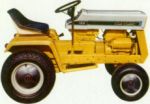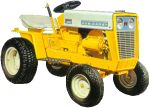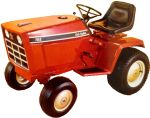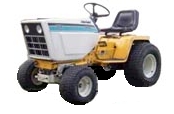
 |
PLEASE PATRONIZE OUR SPONSORS!






|
|||||||
 |
|
|
Thread Tools | Display Modes |
|
|
|
#1
|
|||
|
|||
|
Seems like ignition timing is something that is regularly discussed here on the forum. I have mentioned several times that the best and easiest way to do this is statically with a test light. It requires only a cheap little test light. I believe this method to be the most accurate way to time an engine, no matter what engine it is. After you learn this method, it can be applied to any point ignition system that calls for a timing setting at idle. If however, the engine is to be timed at a certain higher RPM, as in the case of the Cub Lo-Boys (for example) which calls for 16° advanced at high-idle, no-load it will have to be set with a timing light. But, for the good ol' "K" series Kohlers this is my preferred method.
Here's how it works: All you need is a test light. Nothing fancy, although, you may use a multi-meter if you so desire. You need the battery on the tractor to be charged and the ignition system working. If you have the engine out of the tractor, you can do this on the work bench also, you just need a good battery and a wire hooked up to the coil, with a ground strap from the battery to the block. If on the bench, a meter set to OHMs will work the same, then no battery required. (I'll explain that in a minute) testlight.jpg First you have to locate the timing marks on the engine. "K" series Kohlers are always on the flywheel, on the R.H. side of the machine (Starter side). There is a "window" in the flywheel housing so you can see this mark. There are two different places for the window depending on the series of engine you have. Consult the service manual to find out where it is on your engine. In the pics I use today, it is a K301 in a 125 Cub Cadet. tmghle2.jpg Once you find the hole, rotate the engine by hand to find the timing marks. There are two. One for TDC (Top Dead Center) usually stamped with a "T". The other mark is for timing, and usually stamped with an "S". Tmgmrks.jpg Now, roll the engine until the "S" is in the window, then line the dash mark (-) up in the center of the window. If you can't find the marks, go take the point cover off and roll the engine watching the points. When they just start to open, you should be really close. It would be a good time if installing new points to gap them to .020". With this gap, the timing marks on the flywheel will be easier to find if you are having difficulty. (If not sure how to do that, refer to the service manual for your engine.) cntrdinwndw.jpg Now, you need to make sure that you are on the compression stroke. Simplest way to do this is to look at the points. Pull the cover off if you haven't already. When the "S" is in the window, the points should just be starting to open. Go ahead and roll the engine in direction of rotation and see that they open up the rest of the way. If so, good deal, go put the "S" mark back in the center of the window. If not, roll the engine forward one full revolution and line the "S" back up. Repeat the above check to see that it is now on the correct stroke. If you can't get the points to open..... stop. You either don't have them set tight enough, or there is a bigger issue. Once you have the marks located, and you are sure you are on the correct engine stroke, you can now proceed to properly time your engine. Hook the negative end of the test light (alligator clamp end) to the negative (-) battery terminal. I always touch the light to the battery to make sure it works and that I have good connection. Nothing like a burnt out bulb in the test light to make you pull your hair out! negtvepst.jpgdblck.jpg Now, have your screwdriver ready (or whatever tool your using to set the points) and turn the key on. Touch the end of the test light to either 1.) The side of the coil that is attached to the points (negative (-) terminal of the coil) or 2.) to the wire at the points. Either place is fine. Rock the points closed, then open them slowly with the screwdriver. Just as the points contact breaks, the test light will light. Note: Sorry, no points pics. I assume that everyone knows what points look like, and I didn't want to take the point cover off my engine just for a pic. That lower screw is a pain to install.  lghtsupwhenrght.jpg It's at this very point you want to lock the points down. Once locked, roll the engine backwards by hand about an eighth to a quarter turn. Put the test light back on the wire that you were touching, it should be out, then roll the motor forward slowly. When the test light lights stop immediately. Go over to the timing window and check the mark. It should be in the center of the window. If not, repeat process until it does. You may find that you have to move the timing mark just slightly off center in the window to achieve while setting the points to achieve perfect time. Example: If you are constantly finding that the mark is too high when done, try putting it lower in the window while setting the points. On the bench: I mentioned before that you can do this with the engine on the work bench with no battery needed. You just need a multi-meter with an ohm setting. You do the exact same process as above, only you attach the negative (-) or black meter wire to the block. Some meters have alligator clips that can be used in place of the "pointy" end. You can use a bolt and a large washer to "pinch" the metal probe to the block if you don't have the clips. Use the positive lead (+ or red) and touch the terminal on the points that the wire hooks to that runs to the coil. Again, using all the same methods, as above, the meter will go to infinite ohms when the points break. Well, hopefully this helpful to some. I learned this method (this is true) when I was around 12 or 13 when I put a set of points in our old 71 Cub Cadet. I didn't know how to set the timing. My dad said, "Here, I'll show you once, then you can do it." He showed me how, and I never forgot. By far, the most simple way to time an engine.  One of our members kindly converted this to a PDF that can be printed. Here is the link: https://docs.google.com/file/d/0B3to...SWs/edit?pli=1 |
|
#2
|
||||
|
||||
|
Another GREAT post,
 Nik,
__________________
It dont cut grass, but its yellow. |
|
#3
|
||||
|
||||
|
Great post! You must have a great Pa!!!!
|
|
#4
|
||||
|
||||
|
Thanks for this. I've been curious how timing works, and now I know.
__________________
Daniel G.  . (May 1970) 147 w/an IH spring assist, 48" deck, 42" blade, 1969 73, #2 trailer, 10" Brinly plow and (on loan) Dad's #2 tiller. |
|
#5
|
|||
|
|||
|
Thanks for another great TT article!
Seems like these should be stickies? Maybe one TT per post, in a series, with all other comments deleted in between, then locked. Obviously a week or so for discussion before the lock/delete, per topic, would be nice if someone has a suggestion or question that becomes included in the write-up. |
|
#6
|
||||
|
||||
|
nice write up j
|
|
#7
|
||||
|
||||
|
Quote:
 So good in fact, I think all your TT write-ups should be in the Tech section or stickied or whatever you Mods feel is best. It would make them easier to find them for the newbies. I know just to search your posts but some may not. So good in fact, I think all your TT write-ups should be in the Tech section or stickied or whatever you Mods feel is best. It would make them easier to find them for the newbies. I know just to search your posts but some may not.
__________________
Travis 1993 Cub Cadet 2064 1988 Cub Cadet 2072 1980 IH Cub Cadet 782 w/CH20 1966 IH Cub Cadet 102 w/K301 1961 IH Cub Cadet O 1967 IH Cub Cadet 102 & 122     JD 2155 w/ 175 loader |
 |
|
|
Cub Cadet is a premium line of outdoor power equipment, established in 1961 as part of International Harvester. During the 1960s, IH initiated an entirely new line of lawn and garden equipment aimed at the owners rural homes with large yards and private gardens. There were a wide variety of Cub Cadet branded and after-market attachments available; including mowers, blades, snow blowers, front loaders, plows, carts, etc. Cub Cadet advertising at that time harped on their thorough testing by "boys - acknowledged by many as the world's worst destructive force!". Cub Cadets became known for their dependability and rugged construction.
MTD Products, Inc. of Cleveland, Ohio purchased the Cub Cadet brand from International Harvester in 1981. Cub Cadet was held as a wholly owned subsidiary for many years following this acquisition, which allowed them to operate independently. Recently, MTD has taken a more aggressive role and integrated Cub Cadet into its other lines of power equipment.
This website and forum are not affiliated with or sponsored by MTD Products Inc, which owns the CUB CADET trademarks. It is not an official MTD Products Inc, website, and MTD Products Inc, is not responsible for any of its content. The official MTD Products Inc, website can be found at: http://www.mtdproducts.com. The information and opinions expressed on this website are the responsibility of the website's owner and/or it's members, and do not represent the opinions of MTD Products Inc. IH, INTERNATIONAL HARVESTER are registered trademark of CNH America LLC
All material, images, and graphics from this site are the property of www.onlycubcadets.net. Any unauthorized use, reproductions, or duplications are prohibited unless solely expressed in writing.
Cub Cadet, Cub, Cadet, IH, MTD, Parts, Tractors, Tractor, International Harvester, Lawn, Garden, Lawn Mower, Kohler, garden tractor equipment, lawn garden tractors, antique garden tractors, garden tractor, PTO, parts, online, Original, 70, 71, 72, 73, 76, SO76, 80, 81, 86, 100, 102, 104, 105, 106, 107, 108,109, 122, 123, 124, 125, 126, 127, 128, 129, 147, 149, 169, 182, 282, 382, 482, 580, 582, 582 Special, 680, 682, 782, 782D, 784, 800, 805, 882, 982, 984, 986, 1000, 1015, 1100, 1105, 1110, 1200, 1250, 1282, 1450, 1512, 1604, 1605, 1606, 1610, 1615, 1620, 1650, 1710, 1711, 1712, 1806, 1810, 1811, 1812, 1912, 1914.